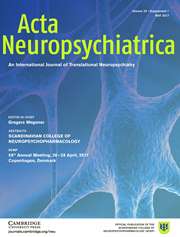No CrossRef data available.
Article contents
The tryptophan catabolite pathway in major and simple neurocognitive psychosis: a double-edged sword with two sharpened edges
Published online by Cambridge University Press: 02 September 2025
Abstract
There are differences in IgA responses to tryptophan catabolites (TRYCATs) in major neurocognitive psychosis (MNP) versus simple neurocognitive psychosis (SNP) and normal controls. MNP and SNP are distinct schizophrenia classes which are differentiated by neurocognitive deficits, phenome features, and biomarker pathways. Nevertheless, there is no data on serum concentrations of those TRYCATs in MNP and SNP. The aim of the present study is to examine serum concentrations of tryptophan and TRYCATs in MNP versus SNP and controls.
This case-control study examines serum levels of tryptophan and TRYCATs in 52 MNP patients, 68 SNP patients and 60 controls in association with overall severity of schizophrenia (OSOS).
MNP patients show lower tryptophan, kynurenic acid (KA), 3-OH-anthranilic acid (3HAA), and higher anthranilic acid (AA) and quinolinic acid (QA) than SNP patients and controls. There were no differences between SNP and controls in these TRYCATs. Kynurenine (KYN) was lower in MNP+SNP than in controls. We found that 36.5% of the variance in OSOS was explained by the combined effects of lowered tryptophan, KA, and 3-HK, and increased QA and AA. The most important biomarkers of MNP and OSOS were the QA/KA ratio followed by the QA/3HAA ratio.
The alterations in serum TRYCAT levels further emphasize that MNP and SNP represent two biologically distinct subtypes of schizophrenia. The reductions in TRYCATs diminish the antioxidant and immunoregulatory functions of the TRYCAT pathway. Elevated QA levels may exacerbate the disruption of the blood-brain barrier and the immune-related and oxidative neurotoxicity in MNP.
Information
- Type
- Original Article
- Information
- Creative Commons
- This is an Open Access article, distributed under the terms of the Creative Commons Attribution licence (http://creativecommons.org/licenses/by/4.0/), which permits unrestricted re-use, distribution and reproduction, provided the original article is properly cited.
- Copyright
- © The Author(s), 2025. Published by Cambridge University Press on behalf of Scandinavian College of Neuropsychopharmacology

